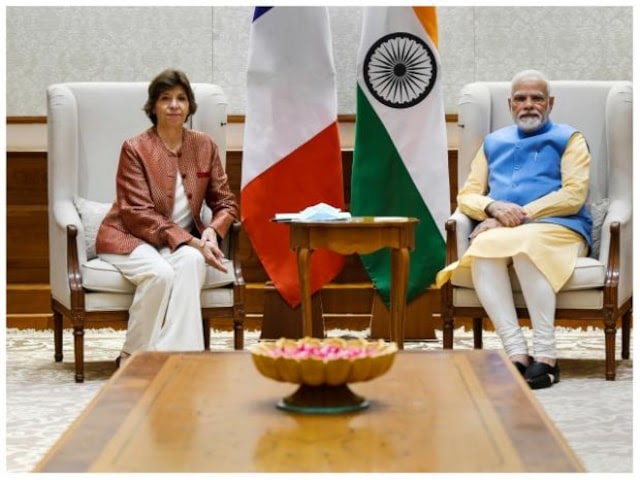
Prime Minister Narendra Modi with French Minister for Europe and Foreign Affairs Catherine Colonna in New Delhi
By Vikas Gupta
Defence News of India, 16 September 22
Paris insists on the opportunity to consolidate its strategic defense partnership with India. Through French Foreign Minister Catherine Colonna, President Emmanuel Macron conveyed to New Delhi the offer of a “limitless” defense and security partnership, with full operational cooperation in Indo -Peaceful.
For France, still reeling from Australia’s cancellation of a $90 billion order of conventional Shortfin Barracuda submarines from French shipbuilders, Naval Group, India offers an irresistible strategic opportunity.
It lies in the Indian Navy’s proposed acquisition of six Air Independent Propulsion (AIP) submarines, designated Project 75-I – a tender that is currently in the doldrums. Of the five foreign original equipment manufacturers (OEMs) that responded to the New Delhi tender, only two met the requirement to have a “sea-proven AIP”. The other three handed in lists of about 20 reasons not to bid.
A common reason was the MoD’s insistence on “incredibly high indigenization”. The ministry demanded indigenization of 45% for the first submarine and 60% for the six boats in the order. OEMs say such high indigenization is impossible.
Under these circumstances, former naval admirals say that Project 75-I should be canceled and the acquisition of six AIP submarines restarted, along with the acquisition of six nuclear-powered attack submarines ( known by the acronym SSN).
Paris would never have considered selling nuclear submarine technology to India. But now, as the UK and US close ranks against China in the Western Pacific, there is precedent for the supply of nuclear submarines to India. In September 2021, as an incentive to join AUKUS, the US and UK pledged to supply Australia with nuclear submarine propulsion technology.
While Canberra was quick to cancel the Barracuda order, France called it a “stab in the back”. He set the stage for Naval Group to offer New Delhi the technology that goes into its Barracuda nuclear submarine, as well as conventional Shortfin Barracuda boats.
India’s ocean geography, which spans 7,500 kilometers of coastline, requires the Indian Navy to operate small conventional short-range submarines; as well as large, long-endurance nuclear-powered boats (submariners call their ships boats).
Pakistan-focused Project 75-I is looking for six submarines for operations in the shallow waters of the Arabian Sea. Like the six Scorpène boatsbuilt at Mazagon Dock Ltd (MDL) under Project 75, the Project 75-I tender targets submarines capable of operating in only 8 meters of water. This is essential, as the waters 25 kilometers off Karachi are only 40 meters deep. Only small boats, such asyouThe 1,565 ton rockfish can operate in such shallow waters without scraping the bottom.
India also needs larger submarines for the Bay of Bengal coast, where the continental shelf drops steeply and, just 5 kilometers off Visakhapatnam, the ocean bed is 3,000 meters deep. These submarines are expected to be nuclear-powered, possess the endurance to sail submerged through four crucial Southeast Asian straits – Malacca, Sunda, Lombok and Ombai-Wetar – to prevent Chinese warships from entering into the Indian Ocean from the South China Sea.
With a need for both nuclear and conventional submarines, India cannot replicate the all-nuclear submarine model of the United States and France. Having not built conventional submarines for decades, Washington cannot participate in Project 75-I. This only leaves Russia and France with the technology and construction infrastructure to supply India with conventional and nuclear powered submarines. However, neither has a conventional submarine with a sea-proven AIP system.
In 1999, the Cabinet Committee on Security (CCS) pegged the sanctioned submarine force of the Indian Navy at 24 boats, to be built in 30 years i.e. by 2029. With 23 past, not even the first six submarines – the Scorpene class – have been fully delivered.
Project 75-I, which has been categorized as Strategic Partner (SP) Procurement, is progressing even more slowly. Five OEMs —Daewoo Shipbuilding and Marine Engineering (DSME) of Korea; Navantia from Spain; Rosoboronexport from Russia, HDW from Germany and Naval Group from France — Responded to the New Delhi Request for Proposals (RfP) by the July 2021 deadline.
Three of those five – the Russians, the French and the Spanish – were eliminated because they failed to meet the MoD’s technical requirement of having “sea-proven air-independent propulsion (AIP)”. This left only HDW (Germany) and DSME (Korea) in the fray, but even these two shipyards are facing problems.
Korean banks, to whom DSME owes large sums, might not allow it to bid, as the banks see too much financial risk in the current Indian tender.
Industry sources say DSME did not get approval from the Korean government to sell Indian submarines, even though Seoul is a major defense ally of Washington. Additionally, Korea may be reluctant to see India emerge as a rival submarine builder in Asia.
That just leaves Germany’s HDW as a foreign partner in the SP tender. The MoD, which is wary of the idea of a single bidder, has asked HDW to make two bids – one bid to each of India’s two SP shipyards: MDL and Larsen & Toubro.
Industry sources say that if the Indian founders of the RfP, New Delhi should find a political solution to obtain both nuclear and conventional submarine technology. That would likely mean a government-to-government deal with Paris, or the involvement of an Indian trading house.






